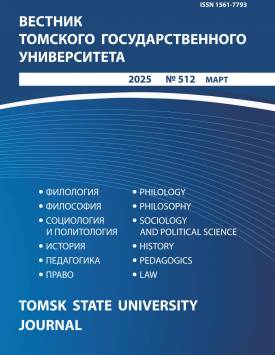Influence of long-distance runners' training characteristics and physical data on their athletic performance
Running has gained widespread popularity in Russia. Many people choose running as a means of beneficial leisure. The growing number of running enthusiasts drives the improvement of methods and tools aimed at enhancing participants' running times. Given that many runners differ in their physical fitness levels and training specifics, this study aimed to determine the influence of physical characteristics and training specifics on the 10 km athletics distance completion time among long-distance runners. The study involved 20 male runners who preferred athletics distances exceeding 10 km and had participated in various athletics competitions, including half-marathons and marathons. The participants were asked to run 10 km on a treadmill and, through a questionnaire, provide information about their physical characteristics and weekly training specifics. The relationship between physical characteristics, training specifics, and distance completion time was analyzed using Pearson correlation. It was found that the distance completion time had a positive correlation with body mass index (r = 0.75). Negative correlations were observed for variables such as training day of the week (r = -0.61), training distance (r = -0.69), training duration (r = -0.61), running experience (r = -0.50), and number of competitions (r = -0.45). Opportunities for optimizing training practices for a broad category of amateur runners were identified. Among all variables, weekly training distance had the greatest impact on running time. Conclusions are presented regarding the influence of long-distance runners' physical characteristics and training specifics on 10 km completion time. The key conclusion is that increasing training distances and the number of weekly training days improves performance in the examined distance. Additionally, it is important to emphasize the favorable impact of experience of participating in long and ultra-long athletics competitions on race results. The authors declare no conflicts of interests.
Keywords
athletics,
health promotion,
long distances,
amateur runners,
training characteristics,
physical dataAuthors
| Grichanov Anton S. | Kikot Moscow University of the Ministry of Internal Affairs of Russia | g-ton@mail.ru |
| Kotelnikov Nikolaj S. | Barnaul Law Institute of the Ministry of Internal Affairs of Russia | kolim005876@gmail.com |
| Bulavkin Aleksandr A. | Kikot Moscow University of the Ministry of Internal Affairs of Russia | bulavkin_aleksan@mail.ru |
Всего: 3
References
Fountaine C., Feito Y. General principles of exercise prescription // Liguori G (Ed). ACSM's Guidelines for Exercise Testing and Prescription. Hong Kong: Wolters Kluwer, 2021. P. 142-166.
Bunker R.P., Thabtah R.P. A Machine Learning Framework for Sport Result Prediction // Applied Computing and Informatics. 2019. Vol. 15, Is. 1. P. 27-33.
Shu D., Wang J., Zhou T., Chen F., Meng F., Wu X., Zhao Z., Dai S. Prediction of half-marathon performance of male recreational marathon runners using nomogram // BMC Sports Science, Medicine & Rehabilitation. 2024. Vol. 16(1). Art. No. 97.
Гайнуллин Р.А., Исаев А.П., Меньшикова Н.В. Корреляционный, регрессионный анализ и возможности моделирования функционального состояния студентов // Теория и практика физической культуры. 2015. № 6. С. 32-35.
Губа В.П. Основы спортивной подготовки: методы оценки и прогнозирования, морфобиомеханический подход: научно-методическое пособие. М.: Советский спорт. 2012. 383 с.
Коновалов В.В., Губа В. П. Прогнозирование спортивного результата у юных легкоатлетов. М.: Центр спортивных инновационных технологий и подготовки сборных команд Департамента физической культуры и спорта города Москвы, 2016. С. 929-933.
Marti B. Health effects of recreational running in women. Some epidemiological and preventive aspects // Sports Medicine. 1991. Vol. 11(1). P. 20-51.
Рыков С.С. Марафонский бег в системе любительских увлечений россиян: статистический анализ и социокультурная рефлексия // Челябинский гуманитарий. 2021. № 1(54). С. 31-38.
Петров Н.Ю., Саватенков В.А., Грошев В.В. Программа подготовки к марафону для бегунов-любителей // Физическое воспитание и спортивная тренировка. 2016. №1 (15). С. 31-34.
Dallinga J.M., Mennes M., Alpay L., Bijwaard H., Baart de la Faille-Deutekom M. App use, physical activity and healthy lifestyle: a cross sectional study // BMC Public Health. 2015. Vol. 15. Art. No. 833.
Tanda G., Knechtle B. Effects of training and anthropometric factors on marathon and 100 km ultramarathon race performance // Open Access Journal of Sports Medicine. 2015. Vol. 6. P. 129-136.
Клочко Л.И. Положительное влияние оздоровительного бега на физиологическое состояние человеческого организма // Педагогика, психология и медико-биологические проблемы физического воспитания и спорта. 2007. № 1. С. 50-54.
Козьмин Р.К., Волков Н.И., Максимов А.С., Нечаев В.И. Тренировочные нагрузки в системе подготовки бегунов к марафонской дистанции. М.: ГЦОЛИФК, 1982. 40 с.
Кашапов Р.И., Кашапов Р.Р. Построение годичного цикла в марафоне // Физиологические и биохимические основы и педагогические технологии адаптации к разным по величине физическим нагрузкам. Казань, 2014. С. 249-251.
Коробов A.H. О беге - почти все. М.: Физкультура и спорт, 1986. 64 c.
Клименко С.С., Болотин А.Э., Тихонов Ю.В. Структурное ранжирование факторов, определяющих необходимость проведения тренировки бегунов на длинные и средние дистанции с учетом особенностей метаболизма // Актуальные вопросы совершенствования физической культуры и спорта. Санкт-Петербург: Санкт-Петербургский университет Государственной противопожарной службы Министерства РФ по делам ГО, ЧС и ликвидации последствий стихийных бедствий, 2021. С. 80-85.
Seiler S. What is best practice for training intensity and duration distribution in endurance athletes? // International Journal of Sports Physiology and Performance. 2010. Vol. 5. P. 276-291.
Gonzalez-Mohno F., Gonzalez-Rave J.M., Juarez D., Fernandez F.A., Barragan Castellanos R., Newton R.U. Effects of Continuous and Interval Training on Running Economy, Maximal Aerobic Speed and Gait Kinematics in Recreational Runners // Journal of Strength and Conditioning Research. 2016. Vol. 30. P. 1059-1066.
Барабаш О.А., Гудков Ю.Э., Мунирова Е.А., Панкрашин Д.А., Мазитова Н.В. Особенности рекреационных занятий с использованием средств оздоровительного бега участников бегового клуба первого зрелого возраста // Ученые записки университета им. П. Ф. Лесгафта. № 11 (189). 2020. С. 41-46.

